For the first three days and nights at ANZAC fighting was almost continuous. The hellish racket of gunfire at the head of Monash Valley, the scene of the most fierce fighting, never ceased. “Whenever it seems on the point of slackening,” Major Brereton wrote, “it immediately breaks out fiercely again.” Denied sleep, by day the ANZACs dug deep into the earth, seeking shelter from the murderous machine-gun, rifle and shrapnel fire, interrupted by bursts of hand-to hand fighting to defend their shallow trenches. At night their nerves were strained to breaking point, waiting for the yelling, onrushing attacks to come at them out of the darkness. The noise was appalling, as Ellis Silas, with the 16th Battalion on Pope’s Hill remembered. Within such a confined area the surrounding cliff faces magnified and echoed the sound. The actual noise level was like a physical blow, approaching the pain threshold, a solid continuous hammering on the ear drums.
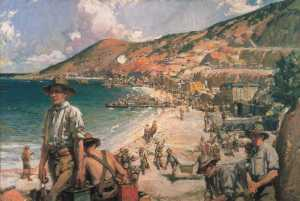
The beach at ANZAC, by Frank Crozier. 1919. Oil on canvas, 123.4 x 184cm. (Australian War Memorial (ART02161).

ANZAC Cove, May 2nd 1915; photo by Lyle Buchanan (Courtesy of Mrs Gail Penrose).
By April 28th the ANZACs were stupefied with fatigue. But by then so were the Turks, who’d suffered dreadful losses. Both sides had fought to a stand-still. The ANZACs couldn’t be dislodged from their ridge-top positions. Neither side could go forward. It was a stalemate.
The battlefield now assumed the features it would essentially maintain until the evacuation in December. As battlegrounds go, ANZAC must have been one of the smallest in modern history. The furthest point inland was a mere one kilometre from the sea, and the entire length of the battlefield, from Quinn’s, along the Second Ridge to Bolton’s, and the sea, was just over two kilometres. Into this constricted area was concentrated over 20,000 men, together with scores of mules, donkeys and horses, plus all their stores and equipment.
With such a lack of space ANZAC very quickly took on the appearance of a gigantic rabbit warren, with holes dug into the hillsides, for personal shelters, as dressings stations for the field ambulances, and as headquarters units. From the sea ANZAC Cove reminded British officer Orlo Williams of “The cave dwellings of a large and prosperous tribe of savages (living) on the steep slopes of broken and sandy bluffs covered with scrub.”
The crescent-shaped beach, just over a kilometre in length, was approached through a hail of shrapnel fire, with shells bursting overhead and lashing the water as in a vicious hail storm. For this reason stores were landed mostly at night. Night, in fact, was the time of the greatest activity in the cove. Then, according to Major Brereton, “the ANZAC position looked for all the world like a great foundry, working strenuous overtime, with sparks flying everywhere, and where shells were bursting great fiery showers flew in all directions... This was accompanied by clanging and cracking that made the likeness complete.” Also at this time lines of men picked their way amongst the mountainous stacks of bully beef and biscuit boxes; amongst the bales of fodder, ammunition cases and all manner of other commodities; past strings of mules, where the unwary soldier could easily receive an unexpected kick if he wasn’t careful; then on to the stacks of kerosene tins, to be filled with water from the two massive tanks on the beach, and carried back by the ration and ammunition parties to their mates on their ridge-top positions.
ANZAC was peculiar in another respect. Battlegrounds, by convention, usually consist of a highly-dangerous, front-line area, where most of the fighting takes place; behind which, to a varying degree there stretches a relatively safer communications area; then miles away, there’s the completely safe base area, where the wounded can receive expert medical treatment and the soldiers enjoy well-earned rest and recuperation. But at ANZAC there was no safe area.
Soldiers could be, and were killed or seriously wounded anywhere, at any time; in the front-line, in the so-called safety of a dressing station, in a “rest area”, while collecting ammunition or rations for their mates, or while having a swim in the sea off the cove.

The dugout Dressing Stations of the 2nd and 3rd Field Ambulances at ANZAC Cove, about two weeks after the Landing. Capt. (later Colonel) Henry Kenneth Fry DSO, is the man standing in the foreground (Australian War Memorial C01734).
ANZAC was surrounded on three sides by the enemy. Turkish artillery occupied the heights on Chunuk Bair to the north east; on Scrubby Knoll and Anderson’s Knoll to the east; and at Gaba Tepe, four kilometres to the south. The field guns at Gaba Tepe provided an almost continuous bombardment of the cove from the time of the landing until the evacuation, while the artillery on Chunuk Bair looking down along Monash and Shrapnel Valleys, provided an equally murderous (enfilading) fire, all along the length of this, the major thoroughfare at ANZAC. In addition, sniper fire was a constant threat to life and limb during these first weeks at ANZAC, and wouldn’t be curtailed (in Monash Valley) until mid-June, by Birdwood’s anti-sniper teams; and the deadly crossfire from the New Zealanders on Russell’s Top.
The “Valley of Death” earned its nickname in May 1915, as did Shrapnel Gully. Then, according to the official historian, C.E.W. Bean: “sniping was most severe in the mornings, when the sun was behind the Turks, and it was a common occurrence for twenty or thirty men to be hit during the morning.”
An all-day-long symphony of discord rang out, and through it all strode Simpson, walking along next to his donkey, forever singing and whistling as he held on to his passenger, scorning the danger, in sweet defiance of all the explosions, the barking rifle fire and the harsh machine-gun chatter, clutching on to one small piece of reality, of nature, in a mechanised world gone mad all around him.
One semi-humorous incident took place at Quinn’s Post, on May 12th, which indirectly involved Simpson. In May the Turkish line was only about fifteen metres from Quinn’s, and the Turks had a nasty habit of throwing their cricket-ball bombs into the front-line trenches at all hours of the day or night. At first these bombs had rather long fuses and the men in Quinn’s often had time to throw them back, or smother them with a sandbag before they exploded. But a number of soldiers were still killed or had their hands blown off in the process.
On May 12th Lieut-General Birdwood, the ANZAC Corps commander and Colonel Monash were in Quinn’s inspecting the front-line positions. Pte. A. Elliott, with the 15th Battalion, had made a delicious stew with vegetables he’d stolen from the QM store (the food was pretty terrible at ANZAC at this time, consisting mostly of bully beef and hard biscuits) and he was carrying a kerosene tin of the boiling mixture along the firing line for the men, when he met the VIP visitors just as a bomb was hurled into the trench. “Not wishing to lose the stew, Elliott stood transfixed as the bomb exploded. Calmly placing the stew down, he removed his boots and, with a penknife, began to extract pieces of the bomb that had entered his feet. Birdwood asked him what he was trying to do, and discovering that the boy was operating on himself, said: ‘That won’t do, my man - you go to the beach.’ Elliott attempted to get to his feet to obey, but found he could not walk. He was taken down to Doctor Luther and afterwards conveyed to the Casualty Station on the beach by Simpson and his donkey.”
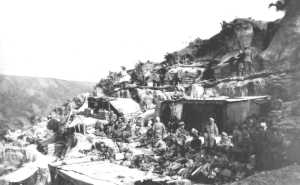
The rear of Steele’s Post, December, 1915. The Firing Line was ten metres from the crest. (Australian War Memorial A00769).
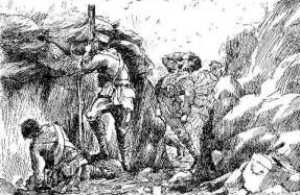
Sketch by Ellis Silas - Quinn’s Post; the Firing Line; May 1915.
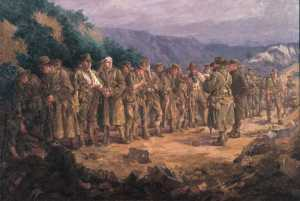
(Above) Roll Call, by Ellis Silas, 1920: Oil on canvas, 101.8 x 153.1cm. Australian War Memorial (ART02436).
16th Battalion (4th Brigade) located on Pope’s Hill and at Quinn’s Post, at the head of Monash Valley, from where Simpson cleared his casualties. At dawn on May 11th, of the original 959 members of the 16th Battalion at the Landing, just over 200 answered the Roll Call.
Quinn’s was the most dangerous and feared post at ANZAC; the most fiercely contested position in the entire line throughout the eight-month campaign. Soldiers in the firing line couldn’t relax for a moment. Quinn’s was defended by men of the 15th and 16th Battalions, who rotated duty there on a 48 hours on, then off basis, during the first weeks.
On May 24th Annie wrote a letter to Jack (which he would never read), telling him: “One of the Fife’s lads has been wounded in the Dardanelles. Do you remember him living opposite us in Frederick Street backlane? He was with the Anson Battalion, such a lot of Shields lads are out there, you will likely meet them.”
Jack did meet one of them, but neither of these two Geordies recognised the other. On May 2nd-3rd Jack was kept busy non-stop after the attack at the Bloody Angle. One of his passengers was a young Englishman, with the Royal Naval Division, who’d been badly wounded in the thigh and was lapsing in and out of consciousness all the way down the valley. Jack had to hold on to him tightly to prevent him falling off the donkey, as they picked their way over the broken ground of Death Valley, to the accompaniment of constant shell and gunfire. Jack would never learn the identity of his passenger. It was Billy Lowes. In one of the strangest quirks of fate these two boyhood friends who’d swapped rabbits as kids, had gone halfway around the world to re-enact a scene they must have played out many times as kids on the sands of Shields. Months later, after he had been medically invalided out of the army and was back in Shields, Billy wrote to Jack’s mother, telling her how, though semi-conscious, he remembered being taken down to the beach on a donkey.
He added, ‘I tell people about your son saving me and losing his own life after doing such good work, and if ever anybody was worthy of a VC it was Jack.’
The first Victoria Cross won at ANZAC was awarded, not to an Australian or a New Zealander, but to a British soldier. L/Cpl. W. R. Parker, a stretcher-bearer with the Portsmouth Battalion of the Royal Naval Division was awarded the VC for helping rescue a number of wounded men from a trench at dawn on May 1st 1915, though wounded himself. Simpson rescued somewhere in the region of three hundred wounded soldiers during his twenty-four days of donkey-trips down Monash Valley.

Near the foot of Shrapnel Gully, 1993. (Photo by Author).
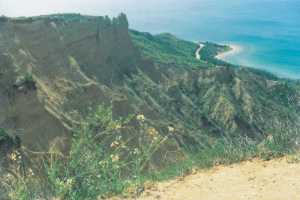
Looking across from Walker’s Ridge to the southern end of Russell’s Top, with Ari Burnu in the distance. (Photo by Author, 1993).
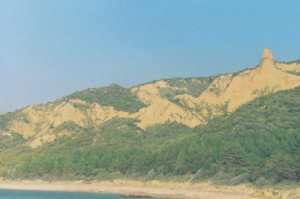
The region where Simpson and 3rd Field Ambulance came ashore, nearly opposite the Sphinx. Much of the beach has since eroded away. (Photo by Author, 1993).
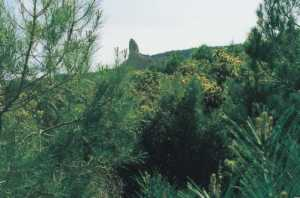
Typical ANZAC vegetation: looking inland from North Beach towards the Sphinx (Photo by Author. 1993). Some of these dense bushes have the consistency of barbed wire. ‘It wasn’t uncommon to have the puttees ripped off your legs as you moved around’ (former ANZAC, Bill Logan of Bundaberg, who was on Walker’s Ridge).





